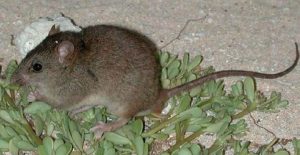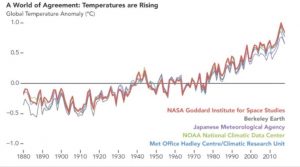APRIL 16, 2019

In late February, the Australian government recognized the extinction of the Bramble Cay melomys, and it is probably the first mammal to go extinct due to “human-induced climate change,” or anthropogenic climate change, according to a report by Queensland scientists.
According to multiple studies published in peer-reviewed scientific journals, 97 percent or more of actively publishing climate scientists have arrived at the hypothesis that “climate-warming trends over the past century are extremely likely due to human activities.”
However, the Oregon Institute of Science and Medicine and its Petition Project stands by Frederick Seitz, an American physicist, and his stance that “there is no convincing scientific evidence that human release of carbon dioxide, methane or other greenhouse gases is causing or will, in the foreseeable future, cause catastrophic heating of the Earth’s atmosphere and disruption of the Earth’s climate.”
The petition also takes the stance that, in fact, there is “substantial scientific evidence that increases in atmospheric carbon dioxide produce many beneficial effects upon the natural plant and animal environments of the Earth.”
About 31,000 American scientists have signed the petition.
About 18 scientific associations have made statements on climate change along with the U.S. National Academy of Sciences, the U.S. Global Change Research Program and the Intergovernmental Panel on Climate Change.

The International Union for Conservation of Nature (IUCN) notes that anthropogenic climate change is “increasingly being acknowledged as one of the greatest threats to biodiversity and human societies alike.”
Regardless of your stance on the cause of climate change, here are some of its effects that have put certain species at risk of extinction according to the IUCN.
1.Increased average temperatures
According to the 2018 Global Climate Report, the yearly global land and ocean temperature has increased at an average of 0.07 degrees Celsius, or 13 degrees Fahrenheit each decade since 1880. However, the average rate of increase since 1981 is more than double that at 0.17 degrees Celsius, or 0.31 degrees Fahrenheit.
With increasing temperatures, one of the animals scientists worry about are sea turtles. The eggs of these reptiles rely on the temperature of the sand that they’re buried in to determine the gender of the hatchlings. With warmer sand temperatures, scientists predict there will be an imbalance in male and female turtles, creating a “significant threat to genetic diversity.”
the IUCN Red list uses the terms vulnerable, endangered or critically endangered to classify how at risk of extinction the species is in the immediate future ranging from high, very high and extremely high, respectively.
The World Wildlife Fund lists sea turtles as vulnerable.
2. Changes in global water cycle
According to NASA, higher temperatures can affect the severity of drought across the world. Climate models available, noted to be state of the art but incomplete and imperfect, “consistently predict that precipitation will become more variable, with increased risks of drought and floods at different times and places.”
An example of animals affected by changes in the global water cycle are African and Asian elephants. Both require great amounts of water daily for drinking, bathing and playing. Rising temperatures and droughts can affect their access to this resource as well as reduce conception rates.
Both species of elephants rely on environmental cues for migration, mostly centered around the availability of water.
The African elephant relies on environmental cues for reproduction, which is tied to rainfall.
The Asian elephant is listed as endangered on the IUCN Red List, while the African elephant is listed as vulnerable.
3.Increasing ocean acidity and rising sea levels
The ocean absorbs about 26% of the carbon dioxide added to the atmosphere from human activities each year according to UNESCO. As the ocean absorbs carbon dioxide, it grows in acidity, which may lead to the ocean becoming corrosive to marine life, possibly as soon as by the end of this century. The acidity doesn’t just threaten plankton, the base of the marine food chain, but also creates inhospitable regions for coral reefs.
Not only do coral reefs face bleaching from rising temperatures, but ocean acidification can reduce calcification rates in reef-building, slowing their growth. Rising sea levels can also lead to the smothering of coral from sediment runoff.
The IUCN Red List has already declared the chisos mountain crested coralroot critically endangered.
4. Continued loss of polar ice
A widely talked about concern of climate change is the melting polar ice. Each September, the Arctic sea ice reaches its minimum. Relative to the 1981 to 2010 average, NASA has recorded the September Arctic ice to be declining at a rate of 12.8 percent per decade.
IUCN’s Red List labels polar bears as vulnerable and lists the loss of Arctic sea ice due to climate change as the most serious threat to the species. Their analysis recognizes the “potential for large reductions in the global polar bear population if sea-ice loss continues, which is forecast by climate models and other studies.”
5. Weather patterns changing frequency and severity of extreme events
The National Climate Assessment found that some extreme weather and climate events have increased in recent decades, some of which might be related to human activities. Climate change is increasing heat waves, the occurrence of heavy downpours and may intensify floods. According to the report, there has been “a substantial increase in most measures of Atlantic hurricane activity since the early 1980s,” as that is when high quality satellite data had first become available. This data is capable of measuring the intensity, frequency, duration and strength of storms.
Scientists theorized in the Queensland report mentioned earlier that an increased frequency in flooding, and possibly increased severity, contributed to the extinction of the Bramble Cay melomys.
Written years prior to the government’s announcement, the report confirmed the extinction of the Bramble Cay melomys was most likely due to extremely high water levels and storm surges, leading to “dramatic habitat loss and perhaps also direct mortality of individuals,” during the last decade.
Courtesy/Source: AccuWeather









































































































